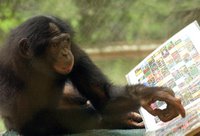Symbol Use and Play in Humans, Chimps, and Bonobos
 Generally, this blog has focused on learning and memory processes in the course of individual development; today's post has a slightly different emphasis: the development of intelligence over evolutionary time. One feature of intelligent behavior is the ability for abstract thinking - and so we might expect that species showing a capacity for symbolic or representational play (summarized as "acting as if") might also be capable of higher level cognition. To what extent is this capacity shared among the highest primates with a recent common ancestor, namely humans, chimps, and bonobos?
Generally, this blog has focused on learning and memory processes in the course of individual development; today's post has a slightly different emphasis: the development of intelligence over evolutionary time. One feature of intelligent behavior is the ability for abstract thinking - and so we might expect that species showing a capacity for symbolic or representational play (summarized as "acting as if") might also be capable of higher level cognition. To what extent is this capacity shared among the highest primates with a recent common ancestor, namely humans, chimps, and bonobos?As described in Lyn, Greenfield & Savage-Rumbaugh's new paper in Cognitive Development (which appears to be loosely based on this talk), it does appear that all these species do have the capacity for such symbolic behavior. The authors then go on to investigate to what extent this capacity for symbolic thought is correlated with linguistic skills, by training some of the primates on "lexigrams," a form of interspecies symbolic communication.
While some previous studies had observed linguistically-untrained primates spontaneously playing highly symbolic and abstract games , other studies found that these games were more likely among primates that were exposed to human culture or had been specifically trained on symbol use.
Based on 99 hours of video tape of five primates - two bonobos and two chimpanzees, where one of each had learned to understand spoken English and could communicate with lexigrams, while the other could not - the authors created the largest database of "pretend behaviors" in primates to date. Here's an example of the kinds of behaviors they observed:
This example details a ritual that developed around a toy snake. Panbanisha [a 3.5 year old bonobo] says “snake” at the keyboard and when Liz asks her where the snake is, she points toward the T-room (toy storage area). They head to the T-room and Liz again asks Panbanisha where the snake is. Panbanisha points toward cabinets and Liz opens them. Panbanisha initially seems tense. She holds onto her caregivers’ neck with both hands, hesitates before indicating a cabinet, and holds her hand up to the door of the cabinet as if to ward off what may come out. When the snake is discovered (a plastic snake normally kept in the T-room), Panbanisha holds more tightly to her caregiver’s neck and does not look at the cabinet as her caregiver slams the door shut on the “snake”, hits the door several times making human approximations of bonobo fear barks, and departs.
After analyzing many such episodes of play, the authors conclude that both chimps and bonobos show the same capacity for pretend play as human children, but that the development of this capacity is remarkably slower, and that training on symbol use is helpful but not necessary for the development of this capacity. In conclusion, the authors remark that the common ancestor of humans, bonobos, and chimps, which was thought to live about 5 million years ago, was most likely capable of symbolic play as well.
Although this study has fairly obvious methodological limitations, it is an interesting foray into phylogenetic approaches to cognitive development.


0 Comments:
Post a Comment
<< Home